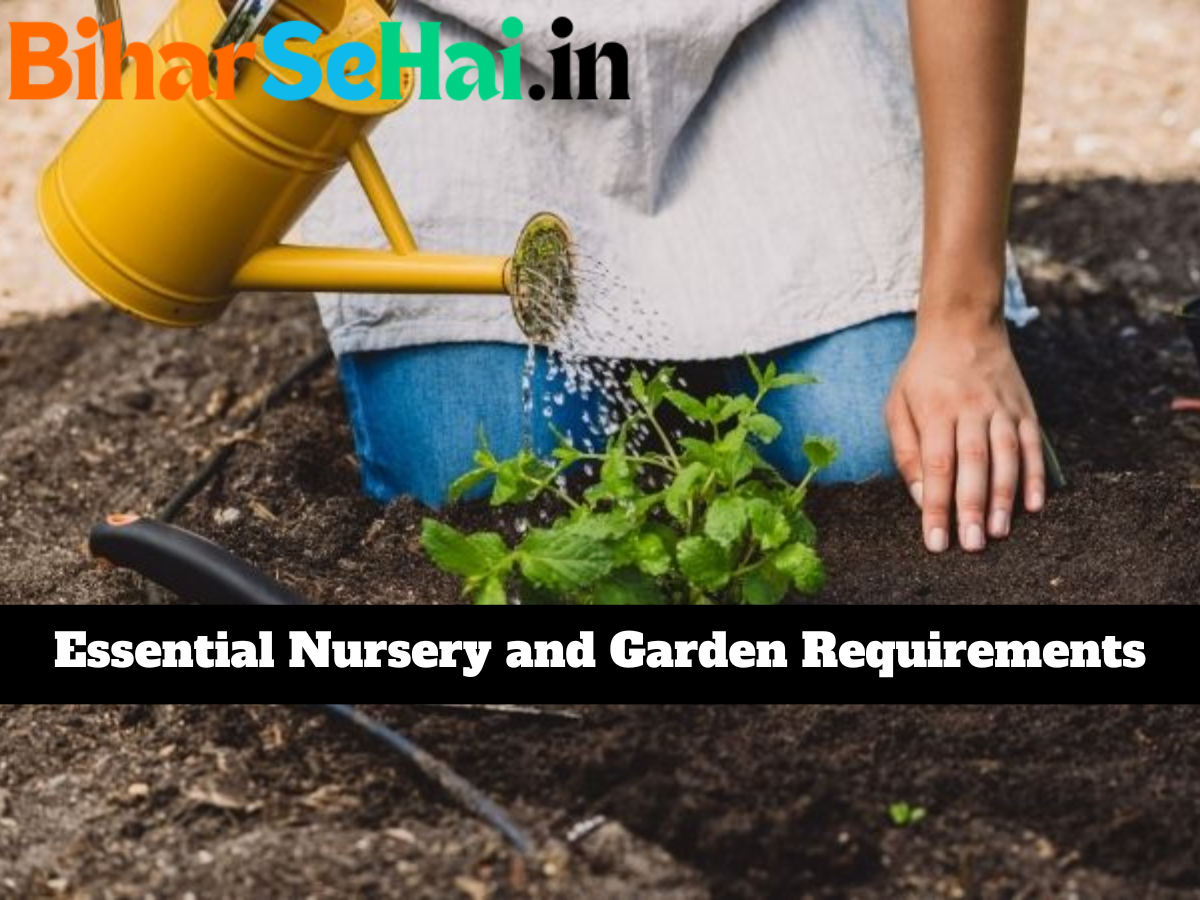Welcome to the wonderful world of home gardening! Starting and maintaining a garden can be an extremely rewarding endeavor, providing beauty, relaxation, fresh produce, and satisfaction. However, a successful garden requires more than just tossing some seeds in the soil. Certain key elements are necessary to help your garden thrive. This article will explore the essential requirements for establishing and caring for a home nursery or garden. Read on to learn critical tips for plant selection, soil health, irrigation, pest control, and more. With the right knowledge, your green thumb will be in full bloom in no time!
What are the best plants for your nursery or garden?
The plant selection process is a critical first step when planning a nursery or garden space. Choose plants suited to your climate and growing conditions. Consider factors like sunlight exposure, soil type, and available space. Opt for a mix of flowers, herbs, vegetables, and ornamentals. Try heirloom varieties for unique color and fragrance. Seek out disease-resistant cultivars to minimize pest issues. Purchase high-quality starters and seeds from reputable nurseries. Group plants with similar light and irrigation needs together. With thoughtful plant selection, your nursery or garden will flourish.
How should you prepare and maintain nursery and garden soil?
Proper soil preparation and care provides the foundation for a thriving nursery or garden. Test soil pH and nutrient levels to determine amendments needed. Incorporate several inches of compost or other organic matter annually to enrich soil texture and nutrition. Use mulch around plants to conserve moisture and suppress weeds. Rotate plant locations each season to prevent nutrient depletion. Mix in balanced fertilizer as needed according to soil test results and plant requirements. Aerate compacted areas to improve drainage. Control erosion on slopes with ground cover plants or stones. With routine soil testing and improvement, your plants’ root systems will stay healthy and vigorous.
What type of watering and irrigation works best?
Consistent watering keeps nursery and garden plants hydrated for optimal growth. New plantings require frequent watering until established. Mature plants need deep weekly soakings of 1-2 inches. Early morning is the best time to water to reduce evaporation loss. Soaker hoses, drip irrigation systems, or watering wands all apply water directly to the soil. Using mulch helps retain soil moisture. Group plants by watering needs for easier irrigation. Be sure to adjust watering schedules for rainfall. Proper nursery and garden irrigation provides the right amount of water at the ideal frequency.
How can you practice effective pest control?
Pest problems can quickly ravage nursery and garden plants. Start with preventative measures like quarantining new plants and cleaning tools. Choose disease-resistant varieties less prone to pests. Eliminate standing water sources which breed mosquitoes. Apply row covers as physical barriers against insects. Use natural predators like ladybugs to manage aphids. Make DIY pest repellents from ingredients like garlic, hot peppers, or neem oil. Remove diseased material immediately to avoid spreading. As a last resort, use targeted organic pesticides sparingly. Consistent monitoring and early intervention are key to effective, eco-friendly pest control.
What tools does every nursery or garden need?
Having a proper set of tools makes nursery and garden tasks easier and more efficient. Essentials include bypass pruners for trimming, digging shovel and spade for soil work, hoe for weeding, and garden fork for turning compost piles. Choose ergonomic tools sized for the user. Invest in quality forged and stainless steel tools that withstand frequent use. Keep a watering can, buckets, and gardening gloves on hand as well. A wheeled cart or wagon helps transport heavier loads. Keep tools clean, sharp, and stored properly to maximize their longevity. Having the right fundamental tools in good working order streamlines garden maintenance.
When and how should you prune trees and plants?
Strategic pruning encourages healthy, vigorous growth in nursery and garden trees and plants. Prune early in the dormant season before buds break. Make cuts just above outward facing buds or branches. Prune for shape and structure, removing crossing, damaged, or inward growing branches. Prune flowering shrubs right after blooming. Shear hedges as needed to maintain size and shape. Always use clean, sharp bypass pruners and loppers for smooth cuts that heal quickly. Disinfect tools between plants or prunings. Removing dead wood opens up air flow and light penetration. Proper pruning promotes strength, productivity, and aesthetic form.
What are the key seasonal gardening tasks?
Garden maintenance requirements vary by season. In spring, apply fertilizer and compost, sow seeds, set transplants, and control weeds. Summer tasks involve watering, staking plants, deadheading spent flowers, and harvesting produce. Fall preparations include planting cool weather crops, dividing perennials, and amending soil. Winter is time to plan next year’s layout, prune dormant trees, and protect tender plants. Schedule regular cleanup of debris and downed branches year-round. Adapting your gardening regimen to the seasonal changes will keep your nursery or garden thriving.
How can you design appealing garden paths and sitting areas?
Garden paths and sitting spaces allow you to fully experience your nursery or garden’s beauty up close. Meandering gravel or brick paths invite leisurely strolls. Stepping stone pathways embedded naturally in the landscape add charm. Clear wide paths of mulch or wood chips for easy access between beds. Surround sitting areas with fragrant flowering plants or herbs. Position chairs and benches in shady spots to relax. Use sturdy, weather-resistant outdoor furniture materials. Define spaces with decorative fences, arbors, or trellises. Solar lighting illuminates paths for nighttime wanders. Functional pathways and seating areas create an intimate connection with your nursery or garden.
What are some key landscaping ideas for nurseries and gardens?
Thoughtful landscaping elevates a basic nursery or garden into an inviting oasis. Frame focal points like specimen trees or water features with ornamental plantings. Repeat certain colors, textures, or plant materials to unify the design. Use hardscaping like fences, arbors, or retaining walls to define spaces. Sculptural elements like birdbaths, statutes, or rock piles add interest. Edge beds cleanly with bricks, stones, or clipped hedges. Use elevation changes, berms, or terraces to create dimension. Incorporate native plants suited for the site conditions and climate. Update landscaping over time as plants mature. Well-planned landscaping transforms a space from ordinary to extraordinary.
How and when should you harvest and preserve garden produce?
Homegrown fruits, vegetables, and herbs are one of gardening’s greatest rewards. Time harvesting correctly for optimal flavor and quality. Pick vegetables like peppers, squash, peas, beans, lettuce, and greens frequently to encourage more production. Allow fruiting crops like tomatoes, cucumbers, peppers, and eggplant to fully ripen on the vine. Harvest herbs just before plants flower for peak flavor. Cut leafy portion of herbs; snip chives at the base. Gather berries when fully colored but still firm. Preserve extras by canning, freezing, or drying. Proper harvesting and preservation techniques allow you to enjoy garden-fresh flavors year-round.
In summary, creating a beautiful, productive nursery or garden requires:
- Selecting plants suited to your growing conditions
- Building healthy soil with compost and mulch
- Using efficient irrigation methods like drip systems
- Controlling pests with preventive measures and organic controls
- Equipping yourself with quality gardening tools
- Pruning overgrown trees and plants at the right times
- Staying on top of seasonal maintenance tasks
- Incorporating paths, seating, and appealing design elements
- Harvesting produce at peak ripeness and preserving extras
We’ve just scratched the surface of essential nursery and garden requirements. With research and hands-on experience, you will continue learning best practices to help your green space flourish. Let your creativity bloom as you cultivate a gorgeous nursery or garden!

